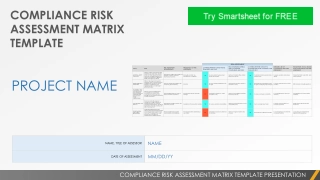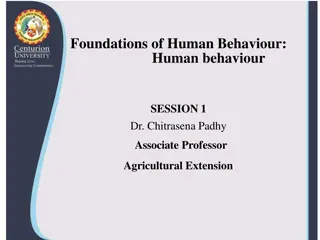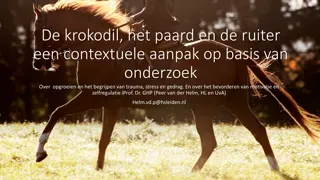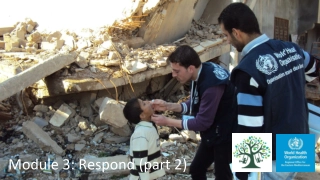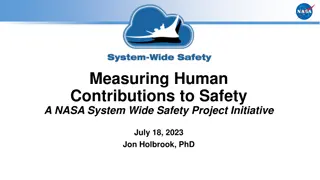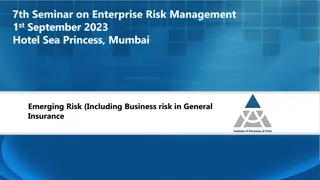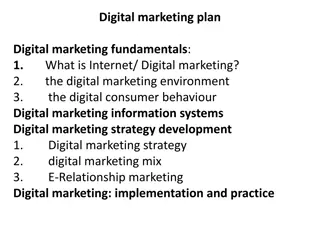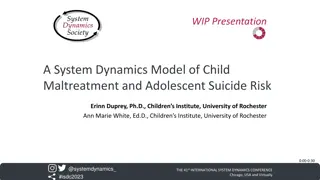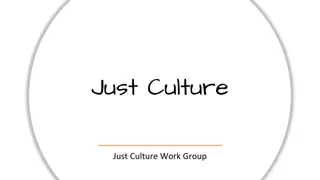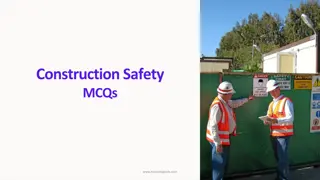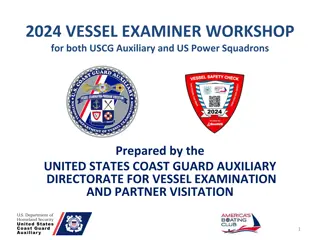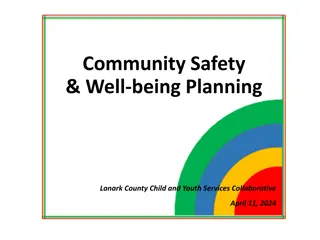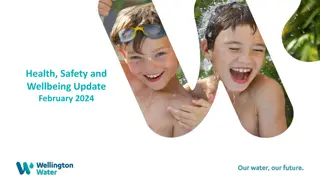Understanding Adolescent Risk-Taking Behavior and Promoting Safety
Adolescents often engage in risky behavior due to a combination of factors like raging hormones, immature thinking, inexperience, curiosity, and boredom. While the adolescent brain is optimized for certain functions, it is still developing in areas related to cognitive control and decision-making. Adults and communities can help keep adolescents safe by understanding their unique challenges, promoting positive alternatives, and providing guidance and support.
Download Presentation
Please find below an Image/Link to download the presentation.
The content on the website is provided AS IS for your information and personal use only. It may not be sold, licensed, or shared on other websites without obtaining consent from the author. Download presentation by click this link. If you encounter any issues during the download, it is possible that the publisher has removed the file from their server.
Presentation Transcript
Why do Adolescents take risks? What can Adults and Communities do to keep them safe?
0.12 Adolescence is physically the healthiest period of the lifespan o Improvements in strength, speed, reaction time, reasoning abilities, immune function o Increased resistance to cold, heat, hunger, dehydration, and most types of injury Yet: overall morbidity and mortality rates increase 200% from childhood to late adolescence Primary sources of death/disability are related to problems with control of behavior and emotion 0.1 0.08 female 0.06 male 0.04 0.02 0 0 10 20 30 40 50 60 70 Age
a. Raging hormones? b. Immature thinking? c. Inexperience? d. Curiosity? e. Boredom?
Adults: The possibility of suffering harm or loss, Danger Youth: Any venturesome undertaking, especially one with an uncertain outcome
Growth spurt of adolescent brain (starting in puberty ) skill efficiency Frontal Lobe: Cognitive control & decision-making still under construction Activity in limbic system (emotional brain): Pleasure and sensation seeking increase
Adolescent cognitive skills and capacities are comparable to adults Lack of experience has impact on their deliberation process (Reyna) When the emotional (limbic) system is aroused, pleasure and reward seeking will be dominant
The teen brain is neither broken nor defective. Rather, it is wonderfully optimized to promote our success as a species. ~Jay Giedd, MD
Increased injury/morbidity Negative behavior outcomes: teen pregnancy, substance abuse, delinquency, school drop out, violence Trying out new things, developing own identity Civic engagement; create social change Early adapters; innovation focused
Temperamental dispositions Youth who mature early (early onset of puberty) are more likely to engage in risky behaviors Peer group increases risk taking Environmental stress
HOMOPHOBIA VIOLENCE SEXUAL EXPLOITATION Social factors that poison youths well-being and healthy development HEALTH THREATS DISRUPTED FAMILY RELATIONSHIPS SEXISM POVERTY LACK OF BENEVOLENT ADULT AUTHORITY
Risks are changing Other
Product Route to home Display Local storage TV stations phone broadcast TV broadcast radio stereo TV radio Cassette/ 8-track Vinyl album News mail Advertising newspaper delivery Radio Stations phone non-electronic paper Tom Wolzien, Sanford C. Bernstein & Co
Product TV stations Info Daily me content Cable Nets Web sites Local news Content from individuals Peer-to-peer Advertising newspaper delivery phone Radio stations Satellite radio Route to home cable phone/DSL wireless broadcast TV broadcast radio stereo satellite mail express delivery pager iPod / storage subcarriers / WIFI cell phone iPod /MP3 Display TV radio PC Local storage VCR server/ TiVo (PVR) PC DVD Web-based storage monitor headphones portable gamer web storage CD/CD-ROM MP3 player / iPod pagers - PDAs cable box game console game console PDA/Palm non-electronic paper storage sticks/disks Adapted from Tom Wolzien, Sanford C. Bernstein & Co
93% of teens 12-17 go online; 63% of these online teens go online daily 73% of these online teens use an online social networking site 31% of social networking teens have friends on their social networking profile whom they have never met personally 71% of 12-17 year olds have cell phones http://www.pewinternet.org/topics/Teens.aspx http://www.youtube.com/watch?v=ZTLGFIl5KCg
Context Matters Family Youth
Supports Services YOUTH Opportunities
Parent-child closeness & communication Modeling healthy behaviors Clear boundaries and expectations Monitoring Know peers Increase connection to school Encourage engagement in social and skill building activities/programming
Integrate social-emotional skill building in program activities Target multiple skill sets such self-regulation, problem solving, conflict resolution Use multiple instruction strategies such as modeling and coaching Involve peer educators Integrate mindfulness and contemplation skills Moment meditations Self inquiry/reflection activities Provide opportunities to identify personal stressors and coping mechanism Critical thinking /media and cultural literacy Creative (multisensory) methods to engage Positive risk taking opportunities Leadership opportunities Outdoor education Civic engagement
Make community safe and supportive Positive role models Opportunities for civic engagement Range of recreational, vocational, social opportunities extra support during transitions
McNeely, C. et al. 2009. The Teen Years Explained: A Guide to Healthy Adolescent Development. Johns Hopkins University School of Public Health http://www.jhsph.edu/adolesc enthealth/_includes/Interactiv e%20Guide.pdf
National Institute of Mental Health. The Teen Brain http://www.nimh.nih.gov/health/publications/the-teen-brain-still- under-construction/index.shtml University of Minnesota Extension. Teens and Risk Taking http://www.extension.umn.edu/family/families-with-teens/fact- sheets/teens-and-risk-taking.pdf University of Minnesota Extension. Parent Resources http://www.extension.umn.edu/family/families-with- teens/resources-parents.html#teen American Academy for Pediatrics. Healthy Children http://www.healthychildren.org/English/ages- stages/teen/Pages/default.aspx Search Institute Family Assets http://www.search- institute.org/system/files/Family_Assets_Framework.pdf
Child Trends www.childtrends.org -Assessing Self-Regulation http://www.childtrends.org/Files/Child_Trends- 2010_10_05_RB_AssesSelfReg.pdf -What Works for Promoting and Enhancing Social Skills http://www.childtrends.org/files/child_trends_2011_03_02_R B_WWSocialSkills.pdf Johns Hopkins Public School of Health Mindfulness Makes a Difference http://www.jhsph.edu/research/centers-and-institutes/center-for- adolescenthealth/_includes/Yoga%20Brief%206%20pg%20interactive% 20FINAL.pdf
University of Illinois Extension. Emotional Intelligence Activities http://my.extension.uiuc.edu/documents/257080502080208/Emotional_I ntelligence_13-18.pdf Zeldin & Collura: Being Y-AP Savvy (Primer for Youth-Adult Partnerships) http://ecommons.library.cornell.edu/bitstream/1813/19325/2/YAP- Savvy.pdf ACT for Youth www.actforyouth.net Youth Development Resources Manual, Narrated Web Presentations, Youth Trends and Data Sources Step it Up 2 Thrive http://www.stepitup2thrive.org Key contributors: Benson (Search Institute), Carol Dweck (motivation) and Richard Lerner (competencies) Harvard Family Research Project http://www.hfrp.org/ Out-of-school time, research and evaluation, data base, bibliography
Search Institute www.search-institute.org Ready by 21 http://www.readyby21.org America s Promise Alliance http://www.americaspromise.org Centers for Disease Control Sample: Teen Drivers http://www.cdc.gov/Motorvehiclesafety/Teen_Drivers/index. html











